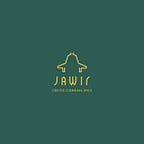INDONESIAN TRADITIONAL FABRICS
“This traditional fabric is also not a mere aesthetic wear object only, but it has a spiritual dimension and a translingual dimension, which shows the already very high level of Indonesian culture” — Widagdo, 1997
As we have talked about in the previous article, one of JAWIR Creative Communal Space’s programs, Satu Lokal Satu Vokal, will be a real contribution in supporting local brands.
Indonesia as the largest archipelago in the world has hundreds of ethnic groups with very diverse cultures. Starting from traditional languages, culinary, traditional fabrics, and many others. Traditional fabrics in Indonesia are one of the local brands in Indonesia
There are so many traditional fabrics that are unique and beautiful in Indonesia, so let's get to know more different kinds of traditional Indonesian fabrics!
Kain Tenun (Woven Fabric)
Woven fabric is a type of fabric made by combining threads lengthwise and transversely. By using a very simple loom, the process of making this woven cloth can take one week to months, depending on the size of the fabric to be made.
Original Indonesian woven fabrics are a favorite because of their beautiful motifs and colors. These woven fabrics are originally from the Nusa Tenggara region, such as Timorese, Troso, Lombok, Sumbawa, and many others.
Sasirangan
Sasirangan is a traditional fabric originally from South Kalimantan. Sasirangan comes from the Banjar language word, which is sirang that means to speak.
The motif is made with stitches using the jelujur technique. Initially, sasirangan fabric was believed to cure disease and ward off evil spirits so that its manufacture was limited.
Sasirangan fabrics are divided into three main types of pattern, namely lajur pattern, ceplok pattern, and variation pattern. These days, sasirangan has been used for everyone even for school uniforms in South Kalimantan.
Batik Jawa
Javanese batik has a different pattern. The difference usually occurs because the patterns have a different meaning, and the meaning is not just a picture but containing the meaning they get from their ancestors, namely adherents of animism, dynamism or Hinduism, and Buddhism.
At first, batik had a limited variety of patterns and colors, and some patterns could only be worn by certain groups.
Javanese batik is widely developed in the Solo area or what is commonly called Solo batik, Yogyakarta or so-called batik Jogja, and Pekalongan or what is commonly called batik Pekalongan.
Kain Ulos (Ulos Fabric)
Ulos is originally from the Batak tribe, North Sumatera. Ulos is generally dominated by red, black, and silver, and with additional patterns of gold and silver threads. At first, ulos was only made in the form of a sarong and scarf.
In the past, ulos was used to complement the appearance of traditional clothes. From the way it is made, ulos is a finely woven fabric that does not use machines.
However, nowadays ulos fabrics can be found in the form of bags, belts, wallets, and other fashion items that are no less fashionable. The colors used such as red, black, and gold give a simple and firm impression.
These are only some of the traditional fabrics from Indonesia because there are actually more. These days, we might not be wearing traditional fabrics as much as Indonesian used to, that is why it is very important to persuade others to wear traditional fabrics. So let’s wear Indonesian traditional fabrics more!
